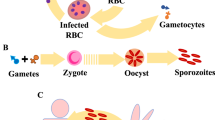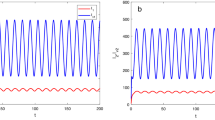Abstract
An intra-host epidemiological model is formulated for the co-infection of drug-sensitive and drug-resistant malaria parasites to examine the impact of aggressive treatment on the effect of competitive release in an infected host. The analysis of the existence of equilibrium and their stability of the model is conducted, and the results reveal that the intra-host competition and treatment play a key role in the prevalence of drug-resistant strains. The mathematical outcomes qualitatively match the experimental fact, that the rapid elimination of drug-resistant strains could promote the very evolution it is intended to retard.








Similar content being viewed by others
References
Anderson R, May R (1991) Infectious disease of humans. Oxford University Press, Oxford
Anderson R, May R, Gupta S (1989) Non-linear phenomena in host–parasite interactions. Parasitology 99:S59–S79
Arnot D (1998) Clone multiplicity of plasmodium falciparum infections in individuals exposed to variable levels of disease transmission. Trans R Soc Trop Med Hyg 92:580–585
Balzarini J, Pelemans H, Karlsson A, De Clercq E, Kleim J-P (1996) Concomitant combination therapy for HIV infection preferable over sequential therapy with 3TC and non-nucleoside reverse transcriptase inhibitors. Proc Nat Acad Sci 93:13152–7
Bushman M, Morton L, Duah N, Quashie N, Abuaku B et al (2016) Within-host competition and drug resistance in the human malaria parasite Plasmodium falciparum. Proc Biol Sci 283:20153038
de Roode J, Culleton R, Bell A, Read A (2004) Competitive release of drug resistance following drug treatment of mixed Plasmodium chabaudi infections. Malar J 3:33–39
Greaves M, Maley C (2012) Clonal evolution in cancer. Nature 481:306–313
Hansen J, Day T (2014) Coinfection and evolution of drug resistance. J Evol Biol 27:2595–2604
Hansen E, Woods R, Read A (2017) How to use a chemotherapeutic agent when resistance to it threatens the patient. PLoS Biol 15:e2001110
Hasting I, Donneily M (2005) The impact of antimalaria drug resistance mutations on parasite fitness, and its implications for the evolution of resistance. Drug Resist Updat 8:43–50
Hastings I (1997) A model for the origins and spread of drug resistance. Parasitology 115:133–141
Hastings I, D’Alessandro U (2000) Modelling a predictable disaster: the rise and spread of drug-resistant malaria. Parasitol Today 16:340–347
Huijben S, Nelson W, Wargo A, Sim D, Drew D, Read A (2010) Chemotherapy, within-host ecology and the fitness of drug-resistant malaria parasite. Evolution 64:2952–2968
Huijben S, Bell A, Sim D, Tomasello D, Mideo N, Day T, Read A (2013) Aggressive chemotherapy and the selection of drug resisant pathogens. PLOS Path 9:e1003578
Kommineni S, Bretl D, Lam V, Chakraborty R, Hayward M, Simpson P et al (2015) Bacteriocin production augments niche competition by enterococci in the mammalian gastrointestinal tract. Nature 526:719–722
Legros M, Bonhoeffer S (2016) A combined within-host and between-hosts modelling framework for the evolution of resistance to antimalarial drugs. J R Soc Interface 13:20160148
Li Y, Ruan S, Xiao D (2011) The within-host dynamics of malaria infection with immune response. Math Bios Eng 8:999–1018
Lipsitch M, Samore M (2002) Antimicrobial use and antimicrobial resistance: a population perspective. Emerg Infect Dis 8:347–354
Lukens AK, Ross LS, Heidebrecht R et al (2014) Harnessing evolutionary fitness in plasmodium falciparum for drug discovery and suppressing resistance. Proc Natl Acad Sci 111:799–804
Mackinnon M (2005) Drug resistance models for malaria. Acta Trop 94:207–217
Mackinnon M, Hastings I (1998) The evolution of multiple drug resistance in malaria parasites. Trans R Soc Trop Med Hyg 92:188–195
Mason D, Mckenzie F, Bossert W (1999) The blood-state dynamics of mixed plasmodium malariae-plasmodium falciparum infections. J Theor Biol 198:546–566
Mckenzie F, Bossert W (1997) The dynamics of plasmodium falciparum blood-state infections. J Theor Biol 188:127–140
Mitchell J, Carr T (2010) Ocillations in an intra-host model of plasmodium falciparum malaria due to cross-reactive immume response. Bull Math Biol 72:590–610
Molineaux L, Dietz K (1999) Review of intra-host models of malaria. Parassitologia 41:221–231
Parida P , Sarma K , Borkakoty B , Mohapatra PK (2016) Structure and functional differentiation of PfCRT mutation in chloroquine resistance (CQR) in Plasmodium falciparum Malaria. Curr Top Malaria
Pollitt L, Mideo N, Drew D (2011) Competition and the evolution of reproductive restraint in malaria parasites. Am Nat 177:358–367
Read A, Taylor L (2001) The ecology of genetically diverse infections. Science 292:1099–1102
Read A, Day T, Huijben S (2011) The evolution of drug resistance and the curious orthodoxy of aggressive chemotherapy. Proc Natl Acad Sci 108:10871–10877
Recker M, Gupta S (2006) Conflicting immune responses can prolong the length of infection in Plasmodium falciparum malaria. Bull Math Biol 68:821–835
Recker M, Nee S, Bull P, Kinyanjul S, Marsh K, Newbold C, Gupta S (2004) Transient crossreactive immune responses can orchestrate antigenic variation in malaria. Nature 188:555–558
Roche-Lestienne C, Preudhomme C (2003) Mutations in the ABL kinase domain pre-exist the onset of imatinib treatment. Semin Hematol 40:80–82
van den Driessche P, Watmough J (2002) Reproduction numbers and sub-threshold endemic equilibria for compartmental models of disease transmission. Math Biosci 180:29–48
Wale N, Sim D, Jones M, Day Salathe R, T, Read A (2017) Resource limitation prevents the emerge of drug resistance by intensifying with-hose comptetion. Early edn. Proc Natl Acad Sci
Walliker D, Hunt P, Babiker H (2005) Fitness of drug-resistant malaria parasites. Acta Trop 94:251–259
Wargo A, Huijben S, de Roode J, Shepherd J, Read A (2007) Competitive release and facilitation of drug-resistant parasites after therapeutic chemotherapy in a rodent malaria model. Proc Natl Acad Sci 104:19914–19919
World Health Organization (2017) World malaria report 2017. World Health Organization
Author information
Authors and Affiliations
Corresponding author
Additional information
Communicated by Florence Hubert.
Publisher's Note
Springer Nature remains neutral with regard to jurisdictional claims in published maps and institutional affiliations.
Appendix
Appendix
Proof
(Proof of Theorem 2) The Jacobi matrix J(E) of right hand side of (2) at E is
At \(P_0\), the eigenvalues of \(J(P_0)\) are
These quantities are negative whenever \(R_0<1\). At \(\tilde{P}=(\tilde{S},\tilde{I}_s,0)\),
The stability of \(E_1\) is determined by the eigenvalue \((1-p)\alpha \beta _2 \tilde{S}-d_3\), which is also equal to \(\frac{(1-p)(d_2 +\mu )\beta _2}{\beta _1}-d_3\). If \(R_2 < R_1\), then this quantity is always less than 0. For \(\hat{P}\), one has
The characteristic equation of \(J(\hat{P})\) is given by
where
It follows from (3) that
and therefore, \(T_2>T_1>0\), \(A>0\), \(B>0\) and \(C>0\). Since
the Routh-Hurwitz criterion tells that \(\hat{P}\) is locally asymptotically stable if and only if \(D>0\). \(\square \)
Proof
(Proof of Theorem 4) The Jacobi matrix J(E) of right hand side of (2) is
At \(P_0\), the eigenvalues of \(J(P_0)\) are
which are negative whenever \(R_0<1\). At \(\tilde{P}=(\tilde{S},\tilde{I}_s,0)\),
The stability of \(\tilde{P}\) is determined by the eigenvalue \((1-p)\alpha \beta _2 \tilde{S}-\gamma _2 \tilde{I}_s-d_3\), which is equal to \(\frac{(1-p)d_2\beta _2}{\beta _1}-\frac{\gamma _2(\varLambda \alpha \beta _1-d_1(d_2+\mu ))}{\beta _1(d_2+\mu )}-d_3\). Recall that \(d_2<d_3\) and \(\beta _1>\beta _2\) due to fitness cost of resistant strain. Then, this quantity is always less than 0.
At \(P^*=(S^*,I_s^*,I_r^*)\), we have
The eigenvalues of \(J(P^*)\) are given by zeros of a third order polynomial. However, we will not provide the detailed expression of characteristic equation for its complexity. The expression of \(J(P^*)\) is enough for carrying out numerical simulations.
In order to show the occurrence of fixed point bifurcation, we change the order of equations of system (1), and let \(I_r(t)=x, I_s(t)=y, S(t)=z\). Then,
Shifting the fixed point \(P_0=(\frac{\varLambda }{d_1},0,0)\) through \({\overline{x}}=x,{\overline{y}}=y,\overline{z}=z-\frac{\varLambda }{d_1}\), we have
Let \(d_3^*=(1-p)\alpha \beta _2 \frac{\varLambda }{d_1}\) and \(\xi =d_3^*-d_3\) be the bifurcation parameter. The Jacobian matrix of system (10) at (0, 0, 0) when \(\xi =0\) is
Accordingly, its eigenvalues are \( \lambda _1=0, \lambda _2=\frac{\alpha \beta _1 \varLambda }{d_1}-(d_2+\mu ), \lambda _3=-d_1\), and the corresponding eigenvectors are
with \(a=\frac{p \alpha \beta _2 \varLambda }{d_1 (d_2+\mu )-\alpha \beta _1 \varLambda }, b=-\frac{1}{d_1}\left( \frac{\beta _2 \varLambda (d_1 (d_2+\mu )-\alpha \beta _1 \varLambda )+ \varLambda ^2 \alpha \beta _1 \beta _2 p}{d_1(d_1 (d_2+\mu ) - \alpha \beta _1 \varLambda )}\right) , c=\frac{\beta _1 \varLambda }{d_1 (d_2+\mu )-\alpha \beta _1 \varLambda -d_1^2}\).
Make the following change of variables
where T is the invertible matrix whose columns are the three eigenvectors obtained above. Then,
where
Denote
Assume the center manifold takes the form of
It then follows that
After some symbolic manipulations, we have
Consequently, the restricted equation of (1) on the center manifold is given by
where
\(\square \)
Rights and permissions
About this article
Cite this article
Song, T., Wang, C. & Tian, B. Modelling intra-host competition between malaria parasites strains. Comp. Appl. Math. 39, 48 (2020). https://doi.org/10.1007/s40314-020-1072-5
Received:
Revised:
Accepted:
Published:
DOI: https://doi.org/10.1007/s40314-020-1072-5




